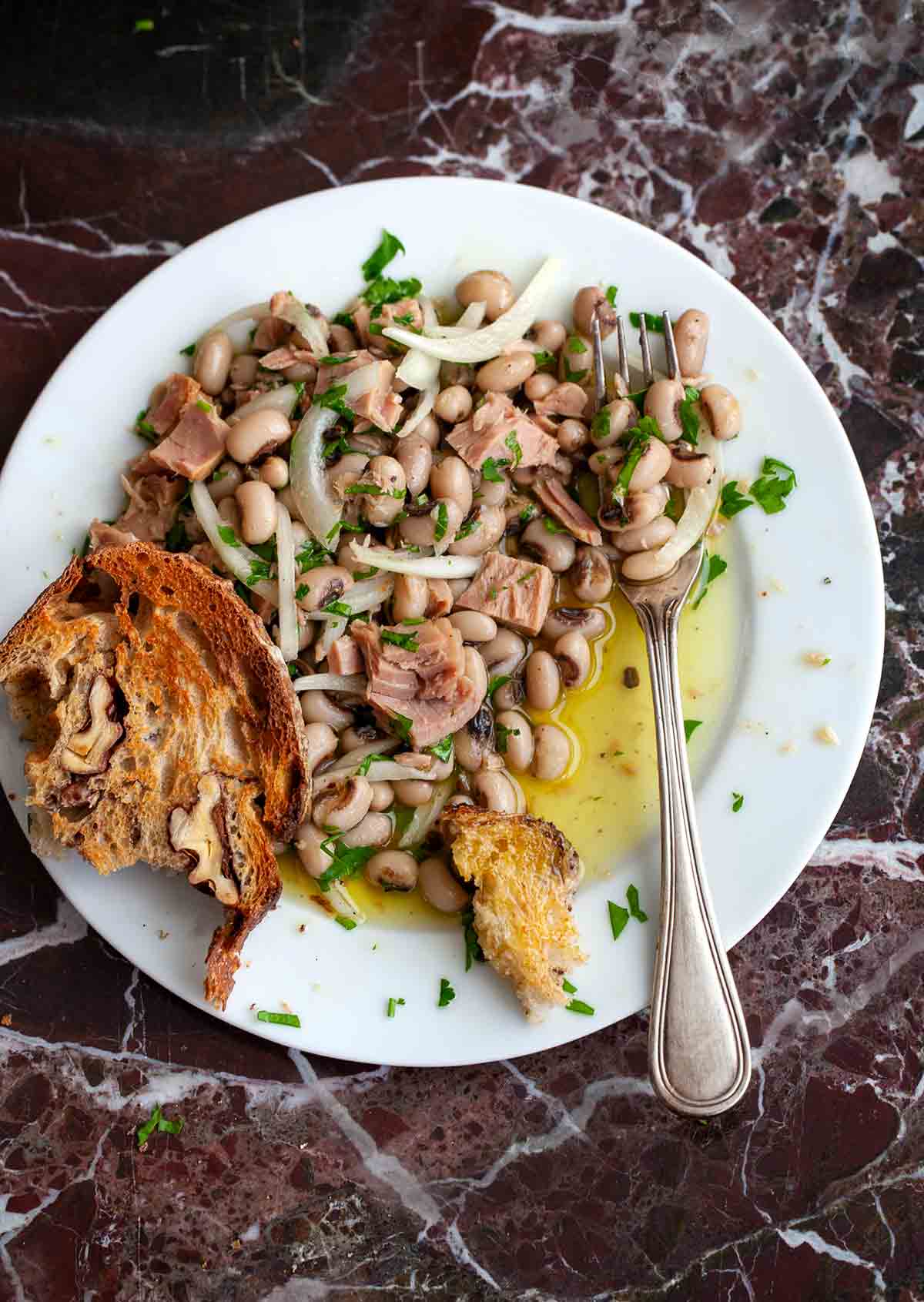
This is a classic recipe popular in the Estremadura region, which is made by home cooks and chefs alike. In my kitchen, I rarely make it the same way twice, and I suggest you do the same. In winter, I’ve eaten it warm crowned with chopped hard-boiled eggs or sliced boiled potatoes that I’ve browned in a skillet. For a light summer lunch, I’ve served it cold with slices of crisp apples or pears. I’ve even served it, minus the tuna, alongside medium-rare grilled tuna steaks as a sort of deconstructed homage to its origins.–David Leite
Want to save this?
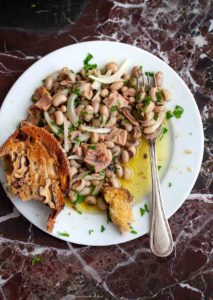
Portuguese Salad of Black-Eyed Peas with Tuna | Salada de Feijão-Frade com Atum
Ingredients
- 1 1/2 cup dried black-eyed peas, picked over and rinsed
- 5 tablespoons extra-virgin olive oil, or more if needed
- 3 tablespoons white wine vinegar, or more if you want a zingier taste
- 1 small yellow onion, cut in half then sliced into thin half moons (about 1/2 cup)
- 2 small garlic cloves, minced
- 4 tablespoons flat-leaf parsley leaves, thinly sliced
- 9 ounces (1 1/2 six-ounce cans) imported tuna in oil, well drained and lightly flaked
- Kosher salt and freshly ground black pepper
Instructions
- Place the black-eyed peas in a large saucepan, add enough water to cover, and soak for 2 hours. Drain and fill the pot with fresh water. Bring to a boil over high heat, reduce the heat to low, and simmer until the beans are tender but still hold their shape, 20 to 30 minutes. Drain and set aside.
- In a small bowl, whisk the oil and vinegar until blended.
- In a large serving bowl, combine the black-eyed peas, onion, garlic, and 3 tablespoons of the parsley. Pour in about 3/4 of the dressing and toss to coat. If you’d like, add some or all of the remaining dressing. Fold in the tuna, season with salt and pepper to taste, and cover with plastic wrap. Refrigerate for at least 2 hours for the flavors to blend.
- Remove from the fridge 30 minutes before serving. Take a taste and, if desired, add a splash of oil or vinegar or season with salt and pepper. Toss, sprinkle with the remaining 1 tablespoon of parsley, and bring to the table. Originally published April 15, 2009.

An LC Original
View More Original RecipesExplore More with AI
Nutrition
Nutrition information is automatically calculated, so should only be used as an approximation.
Recipe Testers’ Reviews
This Portuguese tuna salad recipe is the bomb. All the flavors come together perfectly. I took the description to heart and made it slightly different with what I had on hand.
The first time I made it with pinto beans, in place of black-eyed peas, it was so good. The second time I made I used fresh tarragon, in place of parsley. I did use slightly less olive oil the second time because the recipe had plenty of oil and flavor.
Additionally, it tasted delicious right after it was made. This recipe makes about 8 servings and is an easy go to for the week.
The basic salad is delicious. I love black-eyed peas and have a marinated black-eyed pea salad I make on occasion, and that’s what drew me to this.
In the spirit of never making this the same way twice, when I served more of the salad for lunch a day after first serving it, I plated it over baby arugula. Not only did it look gorgeous, but the peppery greens added a lovely new note to the earthiness of the black-eyed peas and rich, mild fishiness of the oil-packed tuna.
The first time I served this salad, it had been refrigerated for 3 hours and then rested at room temperature for another 30 minutes. By the second and subsequent days, the flavors had married more thoroughly and the salad got even better. It is definitely improved by being made ahead of time as much as possible.
I loved the raw onion in this. At first, I thought there might be too much (especially because the only small onion I had was fairly old and pungent), but I would have been happy with even more onion than was in here. The bite from the onion worked well with the other combined ingredients.
I had some black-eyed peas in my cabinet that I needed to use up and ran across this recipe. Surprise! I had all the other ingredients on hand as well. It seemed the perfect summer meal, and it was. I cooked my peas in the morning and mixed up the salad to let it blend in the fridge. I took it out when I started to make some cornbread to go with it, and I let it sit at room temperature for 30 minutes before serving, as suggested in the recipe. I usually don’t enjoy black-eyed peas without tomatoes, but this was an eye-opener, as it was delicious.
Even my picky hubby enjoyed this one. A perfect light summer meal on a hot, humid day.
I went into this Portuguese tuna salad ecipe a skeptic of a bean-tuna combo, but I came out a believer. It just sort of … works. The black-eyed peas add a nice creaminess and the tuna chimes in with a fresh note. This would for sure be improved by cooking your own black-eyed peas, but my canned ones sufficed. However, I would not recommend using any but the fanciest canned tuna.
Easy, delicious, satisfying. This Portuguese tuna salad recipe is perfect for a quick lunch, a light dinner, or maybe part of a summer cold salad buffet. It came together quickly, and despite having just a few basic ingredients, it really packed great flavor. This will be a staple in our house.
I used canned black-eyed peas, which worked great and made it much easier to envision this as a last minute dish.
I adjusted the dressing slightly—for my tastes I think cutting the dressing back by a 1/2 or 1 tablespoon would be sufficient. I held back that amount after dressing gradually and tasting and was very happy with the flavor.
Canned tuna and black-eyed beans are ingredients that we always have in the pantry. This is a recipe that we prepare whenever we don’t have time to cook, or we don’t feel like it, but mainly because it is a recipe that the whole family likes a lot. It is much more appreciated in summer, where we can add boiled eggs, tomatoes, potatoes, sweet potatoes, arugula, broccoli—the possibilities are endless.
When you need to rustle up a fast meal that you can enjoy warm and is even better cold, this is the recipe you want. Yes, it’s a Portuguese classic. Yes, it’s economical. Yes, it’s versatile. But wait, there’s more… this recipe effortlessly combines bold and satisfying flavour and texture with a myriad of hidden health benefits. The combination of the black-eyed peas, which are really a bean, and the readily available preserved tuna is chock full of fibre, protein, anti-oxidants, and omega-3 fatty acids to name a few.
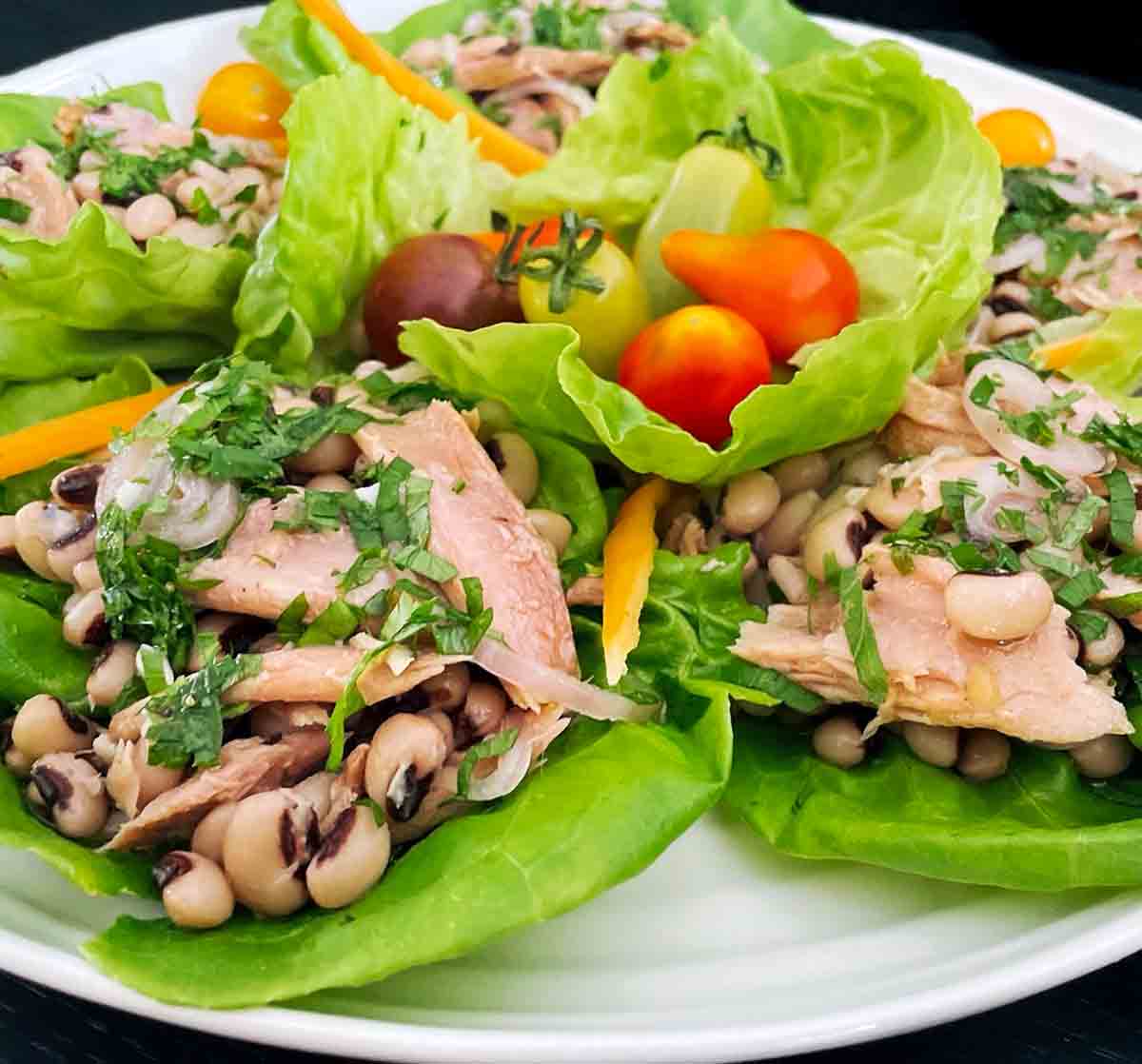
I know! These are not the sentences you expect in a recipe review. However, when you get excited about a recipe, sometimes it’s also great to know that it’s not just about gluttony. Speaking about overeating, this combination is actually satisfying and filling and you will be content for hours.
Make this as written, knowing that you very well may need a bit more olive oil and white wine vinegar. I used an extra tablespoon of each. Black-eyed peas, like many beans, are starchy and have different thirst quotients. It’s also a good idea to season these beans while they are still warm. I used 1/2 teaspoon of kosher salt on the beans and 1/4 teaspoon in the dressing. Also, the quality of the tuna is important. It’s an economical dish. Splurge on the tuna and use your favourite extra-virgin olive oil.
I served my salad in Boston lettuce cups while still warm with slivers of garden hot peppers and cherry tomatoes. We had the leftovers the following day and I agree that the flavours were much more enhanced overtime. No additional dressing was needed on the leftovers but I still drizzled 1 teaspoon of olive oil to bring back the sheen on the black-eyed peas.
Delicious and nutritious!
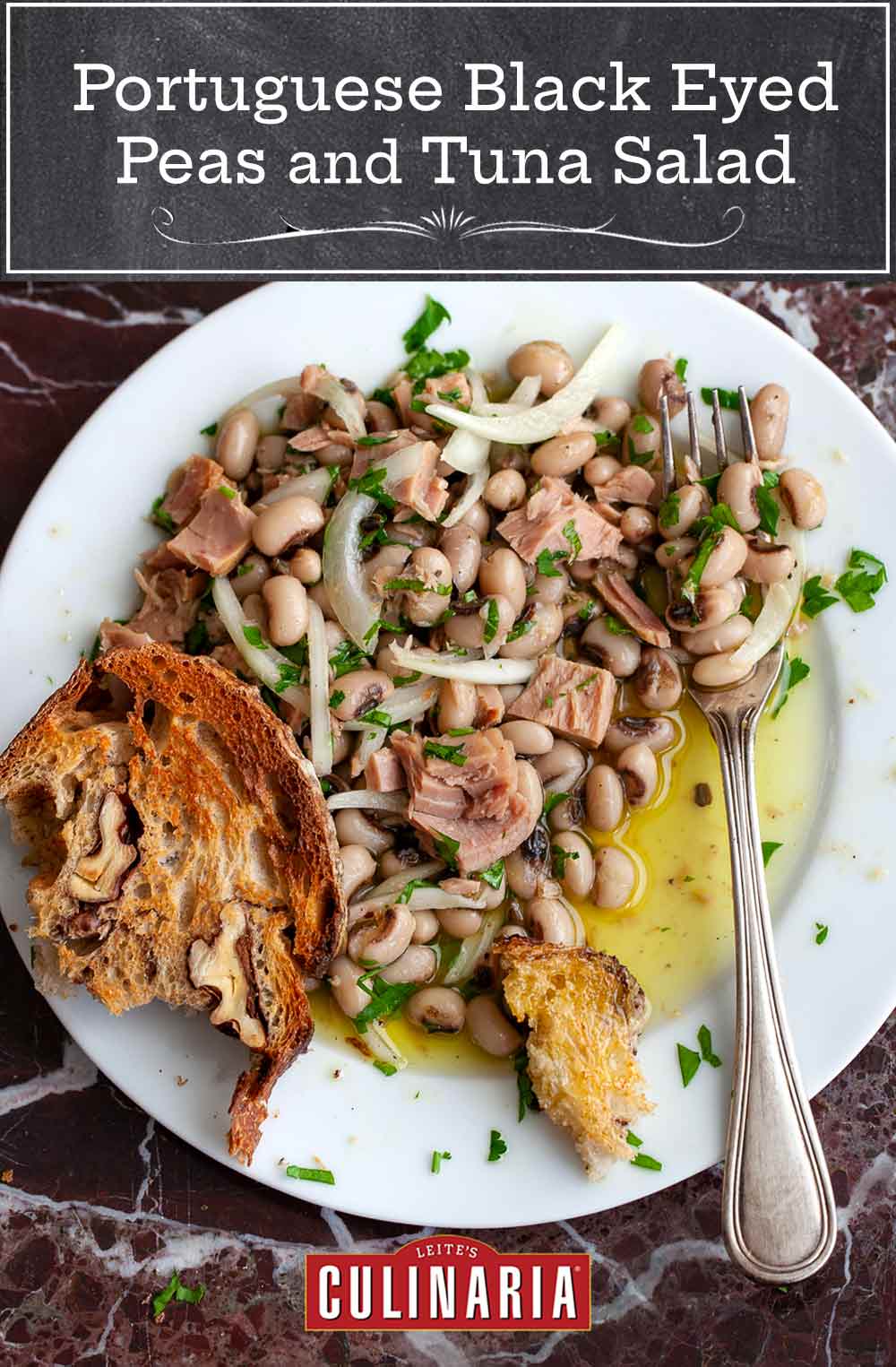
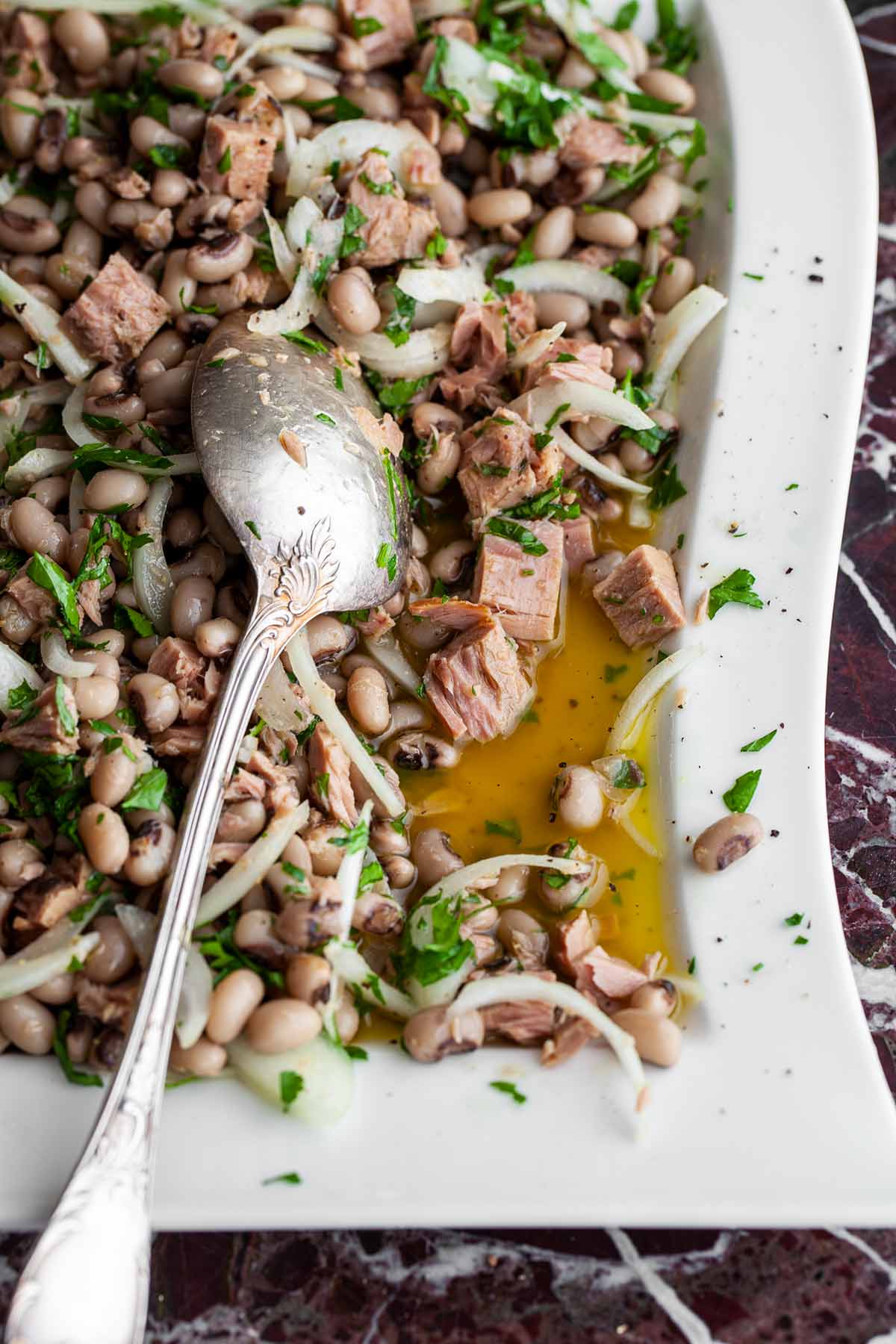















They’re beans not peas, both in Portuguese and English.
Harry, yes, they are indeed beans, but they’re called ‘black-eyed peas” or “cow peas,” at least in America. You can read here that that’s what they’re most commonly known as in English.